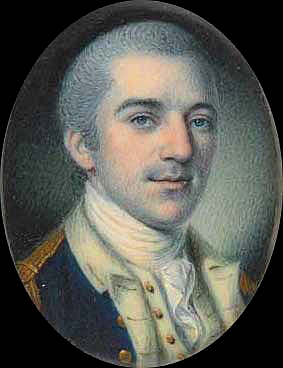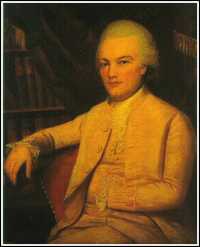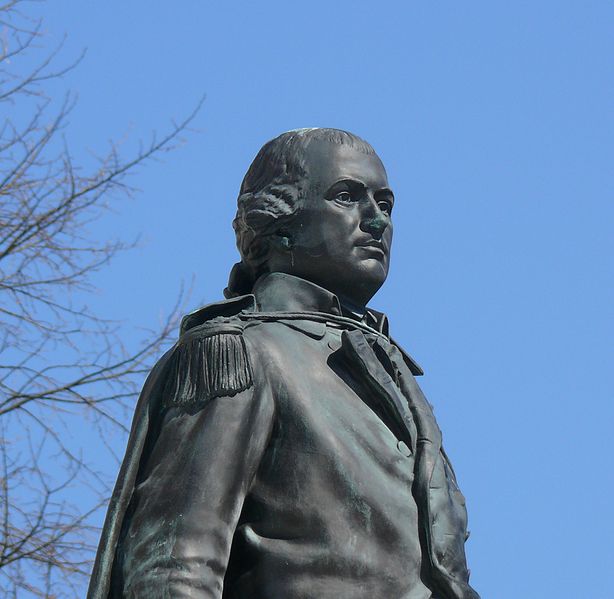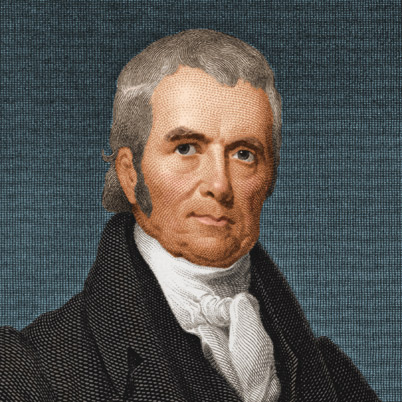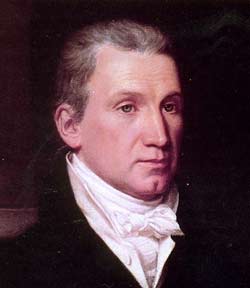Learn more about the Notable People in the history of the Moland House.
The summer of 1777 was a frustrating time for George Washington. The British fleet had sailed from the New York harbor, but where had they gone? Acting on a conjecture that the fleet was bound for Philadelphia, Washington set his troops marching from Morristown, New Jersey to camp at the Cross roads in Warwick Township on the last day of July. The next morning, August 1st, they resumed their march toward the city and arrived at the “plains” near Germantown (above the Falls of the Schuylkill). While his men camped, Washington inspected Philadelphia’s fortifications and spoke with Congress. He also attended a dinner in his honor where he met the Marquis de Lafayette. On August 8th, Washington held a grand review of the troops. After the review, the soldiers marched toward Coryell’s Ferry (now New Hope) in the intense August heat. Washington decided to camp at the Cross Roads on August 8th until future word came about the British. He was to remain there for almost two weeks. As the Moland House was the best finished house in the neighborhood, Washington used it as his headquarters. On August 21st, Washington held a Council of War to determine what the best course of action might be. The decision was to march toward Coryell’s Ferry, but then a courier delivered news of a sighting of the British fleet in the Chesapeake. On August 23rd at 4AM, the main body of the American army began pulling out of the Neshaminy encampment toward Philadelphia. (born 1732-died 1799)
Page under construction.
Lafayette Joins the American Revolution
The Marquis de Lafayette helps the American Cause
There is no doubt the Marquis de Lafayette loved the thirteen American states. It should be remembered by all Americans that without this young man’s help, America would be an entirely different country.
As an example, he wrote his wife in April of 1777:
“The happiness of America is intimately connected with the happiness of all mankind; she is destined to become the safe and venerable asylum of virtue, of honesty, of tolerance, and quality and of peaceful liberty.”
Later he wrote to Henry Laurens, then President of Congress:
“The moment I heard of America I loved her; the moment I knew she was fighting for freedom I burnt with a desire of bleeding for her; and the moment I shall be able to serve her, at any time, or in any part of the world, will be the happiest of my life.”
At the time the Marquis was about 19 years old. He wanted passionately to help and be a member of the American Army. So, with the recommendation of Silas Deane, then serving as an Envoy to France, to grant Lafayette a commision in the “Army of the United States,” Layfayette set out to find the American Army.
 Lafayette as he looked when he first came to America in 1777.
Lafayette as he looked when he first came to America in 1777.
The journey from France to America was to take several months–from April to July of 1777. He landed in South Carolina and had to make a nine hundred mile overland trek to Philadelphia. The roads must have not been what they were in France, for a journey that started out in grand fashion in carriages, soon found all the carriages broken and Lafayette on horseback.
When Lafayette arrived at the Moland House with a commission granted him by Congress for a rank in the Continental Army, Washington refused his request. The General’s explanation was that all ranks were occcupied by experienced and seasoned officers, while Lafayette had no formal military expertise. Washington invited him to join the American cause and in time Lafayette proved his loyalty to America and gained so much military experience that at Yorktown he was closely involved in Cornwallis’ surrender to the French.
At the Moland encampment, Lafayette stayed in a house near the Neshaminy Church. By all accounts his arrival to the Continental Army was welcome. One incident, in front of American troops, which happened presumably at the Moland House encampment:
We are told of a conversation that took place later in the camp between the two Generals soon after Lafayette’s arrival, which met with great satisfaction among our soldiers. “It is somewhat embarrassing to us to show ourselves to an officer who has just come from the army of France,” to which the Frenchman replied, “I am here to learn, and not to teach.” This was his attitude throughout the war. (1)
 Lafayette’s Coat of Arms
Lafayette’s Coat of Arms
If you take a look at The Arms of La Fayette you will see the words, “Cur Non?” For all of you having trouble with the Latin, this phrase means, “why not?” This signified Lafayette’s attitude when people would ask why he would choose to leave the safety of France and the luxury of his birthright.
(1) France and New England, Forbes, Allan and Paul F.Cadman (c) 1925, pp. 3-4
Pulaski at the Moland House
Casimir Pulaski Joins the American Revolution
NOTE – There are a few ambiguities below in the progression of Pulaski’s rank and assigned duties during 1777. These will be addressed. However in the interim, you can use the links in EXPLORE yOUR PAST to clarify those matters for yourself. — Ed Greenawald —
By the time Count Casimir Pulaski met with Silas Deane and Benjamin Franklin in Paris to accept their offer and journey to America to fight for the freedom of the colonies, he already was famous in Europe as a top cavalry commander and an indomitable soldier.
 The opportunity to join the American Revolution was a chance to continue the fight for liberty in another land, and Pulaski eagerly seized it. In August of 1777 he presented his credentials to General George Washington in camp at Moland House, in Warwick, Bucks County, Pennsylvania. Here he also made the acquaintance of the young Marquis de Lafayette for whom he brought letters from France. Wishing to take advantage of Pulaski’s experience, Washington nominated him to take command of the Continental Cavalry, a force then used mostly for reconnoitering and messenger duty. Yet, before the appointment was confirmed by Congress, Pulaski proved his worth by using an improvised cavalry formation to cover the colonials’ retreat at the Battle of Brandywine. He is credited by some historians with saving the American forces from annihilation. Later, he participated in the battles at Germantown and Haddonfield.
The opportunity to join the American Revolution was a chance to continue the fight for liberty in another land, and Pulaski eagerly seized it. In August of 1777 he presented his credentials to General George Washington in camp at Moland House, in Warwick, Bucks County, Pennsylvania. Here he also made the acquaintance of the young Marquis de Lafayette for whom he brought letters from France. Wishing to take advantage of Pulaski’s experience, Washington nominated him to take command of the Continental Cavalry, a force then used mostly for reconnoitering and messenger duty. Yet, before the appointment was confirmed by Congress, Pulaski proved his worth by using an improvised cavalry formation to cover the colonials’ retreat at the Battle of Brandywine. He is credited by some historians with saving the American forces from annihilation. Later, he participated in the battles at Germantown and Haddonfield.
He spent the hard winter of 1777 at Valley Forge organizing and training his cavalry units and shaping them into a strike force. Possibly, because he did not know the English language and American customs well, he ran into disagreements with other officers of the Continental Army. This, and constant wrangling with the army accounting office about receipts for fodder and supplies, tired and disillusioned him. He longed to be in action and requested permission to form an independent mixed unit of cavalry and infantry whose purpose would be to harass the enemy and act as a supporting formation to regular forces. Washington backed this initiative and it was approved by Congress. Soon, the Pulaski Legion, as the unit came to be called, was assembled under its own banner.
While Pulaski was visiting the wounded Lafayette who was recuperating near Bethlehem, Pennsylvania, he ordered an embroidered banner for his legion from the Moravian Sisters, a religious community of women that had settled in the area. The banner bore in its center the letters US — possibly the first such use — and the Latin inscription for “United Valor Is Stronger” in gold on a red background.
* * * * * EXPLORE yOUR PAST * * * * *
Visit Casimir Pulaski 1747-1779: A Short Biography
http://www.chipublib.org/003cpl/pulaskibiog.html
Bibliography: Casimir Pulaski 1747-1779
http://www.chipublib.org/002branches/portage/pocpolbib.html
A Chronology of Casimir Pulaski’s Life 1745-1779
Across old York Road from the Moland House was Major General Nathaniel Greene’s headquarters. All orders to the army were posted here. The whipping post stood there as well and the post office was nearby. On August 17, 1777 General Green wrote General Varnum, “Our situation is not a little awkward-buried in the country, out of hearing of the enemy. His excellency is exceedingly impatient; but it is said, if Philadelphia is lost, all, all is ruined.”
On the morning of August 21st, Major General Nathaniel Green joined in a Council of War in the reception room of the Moland House.
Green was one of the most trusted generals of the Revolutionary army, Washington’s friend and comrade-in-arms. The Greene family was among the earliest settlers in Rhode Island and helped establish the colony. John Greene was the founder of the family in the new colony. Nathanael Greene was born July 27, 1742 (old style, which is August 7, 1742 new style), He died on June 19, 1786.
Alexander Hamilton (1757–1804)
Statesman
King’s College 1774–1776
Trustee 1784–1804
Alexander Hamilton was a Colonel at the Neshaminy Encampment and served as George Washington’s secretary at the War Council on August 20th at the Moland House.
Hamilton was one of the founding fathers of the nation. He joined James Madison and John Jay in writing The Federalist Papers, essays considered the defining discourse on American government. As the nation’s first secretary of the treasury, he laid the groundwork for the American economic system. An advocate of a strong central government, he promoted pro-business policies that spurred the growth of New York as a financial center. He helped found the Bank of New York and the New York Evening Post. He was throughout his life opposed to slavery and openly scornful of those who defended “the peculiar institution.”
Light Horse Harry Lee was at Moland. He was then the Captain of the 1st Troop of the Virginia Militia Cavalry, of Colonel Bland’s regiment of light horse. He was a dashing young man, only a few years of out 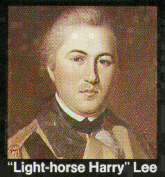 of Princeton. While the troops were filing down York Road away from the Moland House, Captain Lee was facing a court martial at the nearby Neshaminy church for disobedience of orders. The President of the Court, Lt. Colonel White, likely wearing his regiment’s uniform of a green coat faced with red with buckskin breeches, heard the evidence and found the charge against Lee groundless and vexatious, adding that Captain Lee acted merely for the good of his troops.
of Princeton. While the troops were filing down York Road away from the Moland House, Captain Lee was facing a court martial at the nearby Neshaminy church for disobedience of orders. The President of the Court, Lt. Colonel White, likely wearing his regiment’s uniform of a green coat faced with red with buckskin breeches, heard the evidence and found the charge against Lee groundless and vexatious, adding that Captain Lee acted merely for the good of his troops.
Thanks to the verdict of acquittal “with honor”, which was subsequently approved by Washington, Lee went on to a legendary career. He was promoted to major in 1778 and soon earned the nickname “Light Horse Harry” for his exploits. He later became Governor of Virginia, a member of Congress, and the father of Robert E. Lee.
His most famous words were delivered about his friend, George Washington, upon Washington’s death: “First in war, first in peace, and first in the hearts of his countrymen.
(born 1756-died 1818)
Division Commander Major General William Alexander preferred to be called Lord Sterling. His headquarters during the Neshaminy Encampment was a short distance to the east of Moland on Bristol Road, on the farm later owned by Major George Jamison. Tradition holds that George Washington reproved the Major General for his convivial habits while at this encampment. This is not unlikely, as Stirling’s drinking habits were nearly legendary. Even the London gossips, who didn’t believe his claims to a title peerage in Scotland, said he drank like a Lord. It was said he had thirteen glasses of grog before breakfast, one for each of the colonies!
Lord Stirling was present during the Council of War on August 21, 1777. He was born on 1726 and died in 1793 of the gout, probably due to his love of food and drink.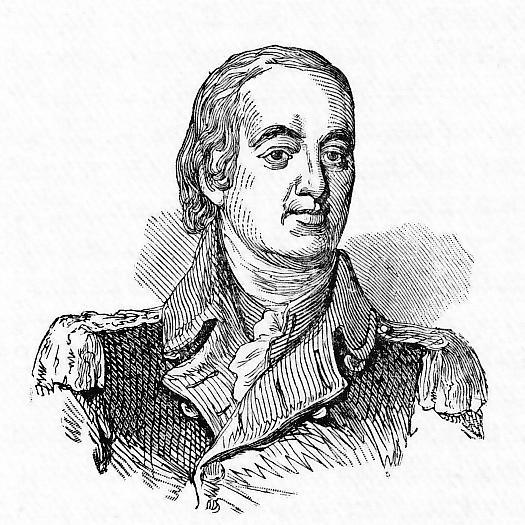
Scotsman Adam Stephen was trained as a physician in Edinburg, but served with the Virginia militia as a soldier. During the French and Indian War he was a colonel and second in command to George Washington. Stephen was at Fort Necessity when Washington surrendered. In 1761 Stephens ran and lost against Washington for the Virginia House of Burgesses.
During the Revolutionary War Stephen was promoted to general for his part in the Battle of Trenton. Major General Adam Stephen took part in the August 21st War Council at the Moland House. In one of his most notable achievements, he forced the retreat of British General Dunmore from Norfolk, Virginia. Stephen was eventually court martialed for unofficer-like behavior. Perhaps his greatest contribution to America’s future was his stirring speech at the Virginia Constitutional Convention of 1788 which influenced the Virginia delegates to ratify the United States Constitution, which in turn led other states to ratify the Constitution at their state conventions.
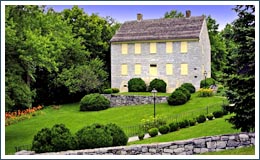 The General Adam Stephen House and Triple Brick Museum is the stone home of the founder of Martinsburg, Revolutionary War General Adam Stephen. It is furnished in 1750-1820 period, and the town museum includes artifacts and local history items such as quilts, military uniforms, and railroading. 309-313 East John St. Martinsburg, WV 25401
The General Adam Stephen House and Triple Brick Museum is the stone home of the founder of Martinsburg, Revolutionary War General Adam Stephen. It is furnished in 1750-1820 period, and the town museum includes artifacts and local history items such as quilts, military uniforms, and railroading. 309-313 East John St. Martinsburg, WV 25401
http://www.orgsites.com/wv/adam-stephen/
Conway, who was born in Ireland but raised in France. He was recruited by Silas Deane, the American ambassador to France. After meeting with General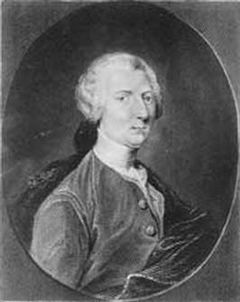 Washington at Morristown in May 1777, Conway was appointed a brigadier general and assigned to Major General John Sullivan’s division. Thomas Conway was present at the Moland House War Council on August 21, 1777. In December of 1777, the Continental Congress named him to the post of inspector general. Conway wrote letters critical of Washington. When these became public he resigned and let the country. This event became know as the Conway Cabal.
Washington at Morristown in May 1777, Conway was appointed a brigadier general and assigned to Major General John Sullivan’s division. Thomas Conway was present at the Moland House War Council on August 21, 1777. In December of 1777, the Continental Congress named him to the post of inspector general. Conway wrote letters critical of Washington. When these became public he resigned and let the country. This event became know as the Conway Cabal.
On March 5, 1770 Knox was a witness to the Boston massacre. He was a bookseller in Boston. As Brigadier General Henry Knox took part in the Moland House 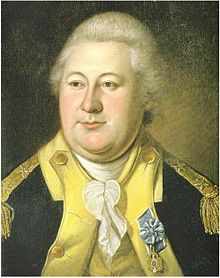 War Council on August 21, 1777. He was in charge of the artillery. In the months before Knox was almost displaced of his position in charge of artillery by a Frenchman named Ducondray. Washington wrote Congress on behalf of Knox on May 31, 1777: “General Knox, who has deservedly acquired the character of one of the most valuable officers in the service, and who combating almost innumerable difficulties in the depar
War Council on August 21, 1777. He was in charge of the artillery. In the months before Knox was almost displaced of his position in charge of artillery by a Frenchman named Ducondray. Washington wrote Congress on behalf of Knox on May 31, 1777: “General Knox, who has deservedly acquired the character of one of the most valuable officers in the service, and who combating almost innumerable difficulties in the depar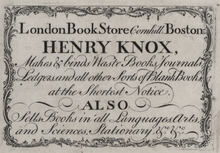 tment he fills has placed the artillery upon a footing that does him the greatest honor; he, I am persuaded, would consider himself injured by an appointment superseding his command, and would not think himself at liberty to continue in the service. Should such an event take place in the present state of things, there would be too much reason to apprehend a train of ills, such as might confuse and unhinge this important department.”
tment he fills has placed the artillery upon a footing that does him the greatest honor; he, I am persuaded, would consider himself injured by an appointment superseding his command, and would not think himself at liberty to continue in the service. Should such an event take place in the present state of things, there would be too much reason to apprehend a train of ills, such as might confuse and unhinge this important department.”
Knox was elected Secretary of War by Congress in 1785, and in 1789 he was appointed Secretary of War in President Washington’s new cabinet.
John Peter Gabriel Muhlenberg sat in the Moland House War Council on August 21, 1777. He commanded the 8th Virgina Regiment (the German regiment). John was born in Montgomery County and was a trained Lutheran minister. The legend goes that as he said farewell to his Woodstock congregation, Reverend Muhlenberg is said to have thrown off his minister garb to reveal his military uniform, saying “There is a time to pray and a time to fight, and that time has now come!” Muhlenberg took part in the fighting at Charleston, Brandywine, Stony Point and Yorktown as well as surviving the winter at Valley Forge. After the war, he felt he could not return to the ministry and served as Montgomery County’s representative to Pennsylvania’s Supreme Executive Council.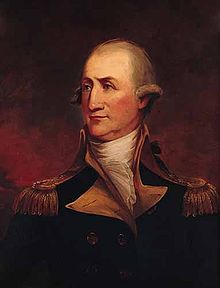
Brigadier General Charles Scott was an orphan who took part in the Council of War Meeting at the Moland House on August 21, 1777. He commanded the 5th Virginia when it joined Washington in New Jersey. Later Scott commanded Washington’s light infantry, and by late 1778 was also serving as his chief of intelligence. He became the fourth governor of Kentucky in 1808 .
.
Major General Anthony Wayne took part in the August 21st Council of War at the Moland House. This Chester County hero led bayonet charges on the British army against overwhelming odds, and lived to tell the tale. Wayne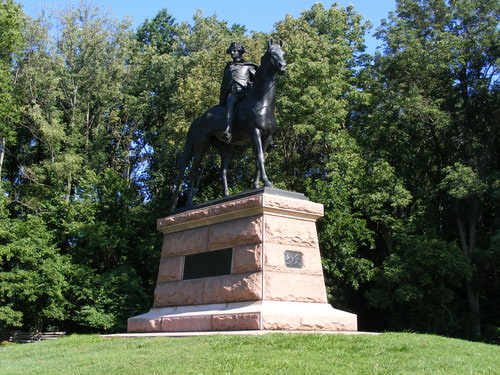 led the Pennsylvania Line (1st & 2nd Pennsylvania Brigades) of the Continental Army. He famously told George Washington that on his order, he would lay siege to Hell. He probably would have. He had a quick temper and fearless nature that earned him the nickname that has stuck with him for more than 240 years, Mad Anthony. The details of his burial are rather interesting and a bit morbid, as he is buried in two spots.
led the Pennsylvania Line (1st & 2nd Pennsylvania Brigades) of the Continental Army. He famously told George Washington that on his order, he would lay siege to Hell. He probably would have. He had a quick temper and fearless nature that earned him the nickname that has stuck with him for more than 240 years, Mad Anthony. The details of his burial are rather interesting and a bit morbid, as he is buried in two spots.
Brigadier General George Weedon took part in the Moland House War Council on August 21, 1777. As the beginning of the revolution, innkeeper Weedon was 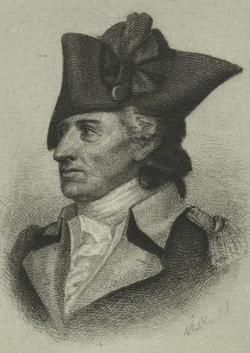 commissioned a lieutenant colonel of the Third Virginia Regiment under Hugh Mercer in 1775. On August 13, 1776, Weedon became a colonel of the 3rd Virginia Regiment. In the fall and winter of 1776, Weedon marched with his troops of the Virginia Regiment alongside General George Washington and the Continental Army in campaigns against the British, including the Battles of Trenton, Brandywine and Germantown. He also commanded PA. and Virginia regiments in Nathanael Greene’s division at Valley Forge.
commissioned a lieutenant colonel of the Third Virginia Regiment under Hugh Mercer in 1775. On August 13, 1776, Weedon became a colonel of the 3rd Virginia Regiment. In the fall and winter of 1776, Weedon marched with his troops of the Virginia Regiment alongside General George Washington and the Continental Army in campaigns against the British, including the Battles of Trenton, Brandywine and Germantown. He also commanded PA. and Virginia regiments in Nathanael Greene’s division at Valley Forge.
Weedon resigned the post he was given in Feb. of 1778 when, Congress promoted William Woodford, to a position outranking him. Although he never returned to full duty in the Virginia regiment, Weedon continued his service to his country by leading a brigade of Virginia militia during the Battle of Yorktown in October 1781. Woodford was captured during the siege of Charleston and died in captivity in 1780. Weedon died in 1793.
Weedon’s orderly book–his record of orders (Including the Neshaminy encampment) and battle plans–from Valley Forge remains in the holdings of the American Philosophical Society in Philadelphia. Read his commission here.
William Woodford was a Brigadier General in charge of the 1st Virginia Brigade while at the Moland House. He attended the War Council on August 21, 1777. Prior to Moland Woodford’s forces defeated a British attack on his headquarters at the Great Bridge, the first land battle of the Revolutionary War in the South on December 9, 1775.
Woodford distinguished himself and was wounded at the Battle of Brandywine on September 11 of that year when his men stopped advancing British troops. Later, Woodford commanded his brigade at the Battle of Monmouth in 1778 and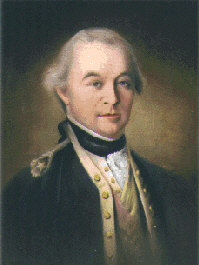 marched to South Carolina to reinforce the army at Charleston. With the surrender of Charleston in May 1780, Woodford became a prisoner of war and died on November 13, 1780, aboard the British prison ship Packet off New York. Woodford County, Illinois, and Woodford County, Kentucky, were named for him, as was the town of Woodford in his native Caroline County, Virginia.
marched to South Carolina to reinforce the army at Charleston. With the surrender of Charleston in May 1780, Woodford became a prisoner of war and died on November 13, 1780, aboard the British prison ship Packet off New York. Woodford County, Illinois, and Woodford County, Kentucky, were named for him, as was the town of Woodford in his native Caroline County, Virginia.
Lt. Colonel Robert Harrison was an aide to the Commander. He did not attend the War Council at the Moland House on August 21, 1777, but he was at the encampment.
http://www.pbs.org/georgewashington/collection/war_1777aug20.html
Lt. Colonel John Laurens was the son of Henry Laurens, president of Congress. John Laurens served as the commander’s secretary while at the Moland House, perhaps due to his fluency in French. John did not attend the Council of War meeting on August 21, 1777. John became friends with Lafayette and Alexander Hamilton.